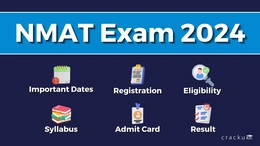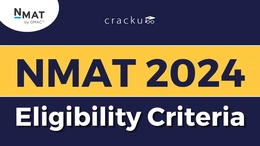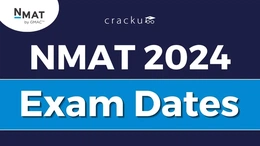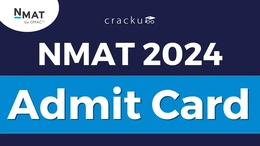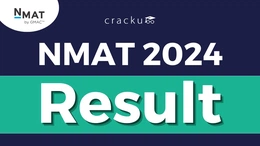NMAT Exam Analysis: The NMAT exam is a computer-based test conducted by GMAC for admission into top MBA programs. It consists of three sections: Language Skills, Quantitative Skills, and Logical Reasoning, each with a specified time limit.
The exam allows for flexible scheduling, multiple attempts, and the freedom to choose the order of sections. It uses a scaled scoring system, with a total score ranging from 36 to 360. The NMAT exam is known for its moderate difficulty level, focusing more on speed and accuracy. It tests candidates on their ability to handle time pressure while solving a variety of logical and analytical questions. Here in this article we have provided NMAT Paper analysis of last 3 years.
Note: NMAT is an adaptive test, which means that the exact number of questions from each topic isn't available from previous year papers. However, based on sample papers and NMAT exam analysis of various exam slots, we can estimate the distribution of questions and their difficulty level. These estimates are further refined using student feedback after the exam, providing insight into the types of questions and the level of challenge experienced.
NMAT Exam Highlights
| NMAT 2024 Highlights | |
| Exam name | NMAT by GMAC |
| Conducting body | Graduate Management Admission Council (GMAC) |
| Exam level | National level |
| Frequency | Once a year |
| Attempts allowed | Up to 3 attempts within 70-day exam window |
| NMAT exam mode | Computer-Based Test (CBT) |
| Syllabus |
|
NMAT Exam Analysis 2024
The NMAT Exam Analysis reveals a moderate difficulty level across all sections: Language Skills, Quantitative Skills, and Logical Reasoning. Questions are designed to test conceptual clarity, speed, and accuracy, with a focus on data interpretation, arithmetic, vocabulary, and critical reasoning.
Quantitative Skills often include diverse topics like algebra, geometry, and number properties, while Logical Reasoning emphasizes pattern recognition and logical sequences. Below, we have provided a detailed section-wise NMAT exam analysis to help understand the trends, question types, and key focus areas for NMAT preparation.
NMAT Quantitative Aptitude and Data Interpretation Analysis
Over the last three years, NMAT's Quantitative Aptitude section has consistently featured a moderate to difficult level of questions. The focus areas include Arithmetic (Profit & Loss, Time & Work), Algebra (Equations, Inequalities), and Data Interpretation (Graphs, Tables).
Arithmetic and Data Interpretation dominated, with fewer questions from higher mathematics. Speed and accuracy remain important due to time constraints. Each year, the section shows a balance between calculation-intensive and logic-based questions, emphasizing both conceptual understanding and quick problem-solving. NMAT exam analysis of this section is given below:=
| Sub-section/ Topic | Type of Questions | No of Questions |
|---|---|---|
| Arithmetic | Interest | 3 |
| Arithmetic | Percentage, Profit & Loss | 7 |
| Arithmetic | Time Speed, Distance and work | 1 |
| Algebra | Equation, Formulae | 2 |
| Modern Math | P&C;, Probability, Log | 8 |
| Number System | Divisions, Multiples | 3 |
| Data Interpretation | Graphs, Tables (2 sets with 4 questions each) | 8 |
| Data Sufficiency | Number sufficiency, Arithmetic calculation | 4 |
NMAT Verbal Ability Analysis
The NMAT Verbal Ability section over the last three years has maintained a moderate difficulty level, focusing on Reading Comprehension, Vocabulary, and Grammar. Reading Comprehension passages are generally short but demand quick analysis, with questions on inference and main ideas. Vocabulary-based questions include synonyms, antonyms, and cloze tests. Grammar questions cover sentence correction, error spotting, and sentence improvement. The trend indicates a balanced mix of vocabulary and comprehension, emphasizing critical reading skills, contextual understanding, and language proficiency. The section tests the candidate's ability to interpret and analyze written information accurately. NMAT exam analysis of this section is given below:
Topic-wise Distribution:
| Topic | Type of Questions | No of Questions |
|---|---|---|
| Verbal Ability | Spot the Error in Underlined Parts; Correction in Sentences | 8 |
Jumbled Paragraphs | Jumbled Paragraph | 5 |
| Vocabulary | Fill in the Blanks | 8 |
| Reading Comprehension | 2 Passages with 4 Questions each | 8 |
| Questions on True False Statement, Argument, Inference, Main Idea, Interpretation of Phrase as used in RC; Passage Title | RC Passage 1 | 4 |
| Miscellaneous | 3 |
NMAT Logical Reasoning and Critical Reasoning Analysis
Over the past three years, the NMAT Logical Reasoning and Data Interpretation section has consistently ranged from moderate to challenging. Logical Reasoning covers areas like Arrangements, Puzzles, Syllogisms, Blood Relations, and Critical Reasoning. Data Interpretation focuses on data sets in the form of tables, charts, and graphs, requiring quick calculations and logical deductions.
Puzzles and pattern-based questions have been frequent, with increasing complexity. The section demands strong analytical skills, quick thinking, and attention to detail to handle the varied question types and the high volume of data-driven problems efficiently. NMAT exam analysis of this section is given below:
Topic-wise Distribution:
| Sub-section/ Topic | Type of Questions | No of Questions |
|---|---|---|
| Analytical Reasoning | Includes Syllogism, Puzzles, Series, Input-Output, Arrangements, Numbers among others | 20 |
| Critical Reasoning | Includes Inference, Assumptions, Weakening of Arguments, Decision Making, Statement-Argument/Assumption/Conclusion | 16 |
NMAT Previous Year Paper Analysis
The NMAT exam over the last three years has maintained a moderate difficulty level across its sections: Quantitative Skills, Logical Reasoning, and Verbal Ability. The focus has been on testing speed, accuracy, and conceptual understanding.
Quantitative Skills emphasizes Arithmetic and Data Interpretation, Logical Reasoning features puzzles and pattern recognition, while Verbal Ability centers on comprehension and vocabulary. Below, we have provided a detailed year-wise analysis for better insights.
NMAT Exam Analysis 2024
Based on the analysis of NMAT previous year papers the expected pattern of the NMAT exam:
- Continued Emphasis on NMAT Data Interpretation and Logical Reasoning: Given the increasing importance of these skills in the business industry,
- Increase in Quantitative Difficulty: The trend of tougher quantitative questions is likely to continue, requiring strong foundational knowledge and problem-solving skills.
- Verbal Skills and Critical Reasoning as Key Areas: Expect more challenging reading passages, grammar questions, and critical thinking problems.
- Overall Increase in Difficulty: The overall difficulty level of the exam is likely to remain high, requiring thorough preparation and practice.
| Sections | Difficulty Level | Difficulty Level | No. of Questions |
| Language Skills | Vocab intensive, easy RCs and Medium Grammar | Easy - Medium | 36 |
| Quantitative Skills | Lengthy questions and tougher than NMAT 2023 | Difficult | 36 |
| Logical Reasoning | Not too hard and not too easy as well. Perfect mix of essy and medium questions | Intermediate | 36 |
NMAT Exam Analysis 2023
The NMAT 2023 exam maintained a moderate difficulty level, with a balanced emphasis on Quantitative Skills, Logical Reasoning, and Verbal Ability.
Quantitative Skills focused on Arithmetic and Data Interpretation, Logical Reasoning featured puzzles and sequences, while Verbal Ability emphasized Reading Comprehension and vocabulary. Time management and accuracy were key factors. NMAT Paper analysis of the year 2023 is given below:
NMAT 2023 Exam Analysis | |||
Section | No.of Questions | Sectional Timing | Difficulty Level |
Language Skills | 36 | 28 | Easy - Moderate (Vocab was not easy) |
Quantitative Skills | 36 | 52 | Moderate |
Logical Reasoning | 36 | 40 | Moderate |
Total | 108 | 120 | Moderate (Slightly difficult than last year) |
NMAT Exam Analysis 2022
The NMAT 2022 exam featured a moderate difficulty level, with Quantitative Skills emphasizing Arithmetic and Data Interpretation.
Logical Reasoning included puzzles, coding-decoding, and critical reasoning, while Verbal Ability focused on Reading Comprehension and grammar-based questions. Speed and precision were crucial to tackle the varied question types within the time constraints. NMAT Paper analysis of the year 2022 is given below:
NMAT 2022 Exam Analysis | |||
Section Name | Number of Questions | Sectional Timing | Difficulty Level |
Language Skills | 36 | 28 | Moderate |
Quantitative Skills | 36 | 52 | Difficult to Moderate |
Logical Reasoning | 36 | 40 | Moderate |
Total | 108 | 120 | Moderate |
NMAT Exam Analysis 2021
The NMAT 2021 exam maintained a moderate difficulty, with Quantitative Skills focusing on Arithmetic, Algebra, and Data Interpretation.
Logical Reasoning included puzzles, arrangements, and series-based questions, while Verbal Ability emphasized Reading Comprehension, vocabulary, and grammar. The test required strong time management and accuracy to navigate the diverse question patterns effectively. NMAT Paper analysis of the year 2021 is given below:
NMAT 2021 Exam Analysis | |||
Section Name | Number of Questions | Sectional Timing | Difficulty Level |
Language Skills | 36 | 28 | Moderate |
Quantitative Skills | 36 | 52 | Difficult to Moderate |
Logical Reasoning | 36 | 40 | Difficult to Moderate |
Total | 108 | 120 | Moderate |
What is a Good Score in NMAT 2024?
A good score in NMAT 2024 typically ranges from 230 to 250, depending on the specific MBA colleges requirements. Scores above 250 can significantly improve your admission chances at top institutions like NMIMS. Each section contributes equally, so a balanced score across Language Skills, Quantitative Skills, and Logical Reasoning is essential. Additionally, individual schools may have varying cutoff scores, making it crucial to research target programs. Consistent preparation and practice can significantly help candidates achieve competitive scores for their desired institutions.
As far as NMAT 2024 is concerned, the section wise good score can vary, but the overall difficulty level was more or less same in all the shifts.
| Language Skills | Quantitative Skills | Logical Reasoning |
| 80 - 85 | 78 - 80 | 80 - 81 |
Key Takeaways for NMAT Exam Analysis
An adaptive test customizes the difficulty of questions based on your performance. If you answer a question correctly, the next one will likely be harder. Conversely, if you answer incorrectly, the next question will likely be easier. This ensures the test accurately measures your ability level. There is no negative marking, so you can attempt all questions without penalty. However, once you move past a question, you cannot go back to it. Therefore, it's crucial to read questions carefully before answering.
- Attempt 100%: Don't forget to attempt all the questions in the exam as there is no negative marking, however if you leave any question unattempted you will face penalty.
- Practice Regularly: Consistent practice is essential to improve problem-solving skills and time management.
- Focus on Fundamentals: Strengthen your understanding of basic concepts in quantitative aptitude, logical reasoning, and language skills.
- Develop Time Management Strategies: Practice answering questions within the allotted time to avoid rushing.
- Improve Reading Comprehension: Read a variety of texts to improve your reading speed and comprehension.
- Mock Tests: Take as many mock tests as possible to know about the NMAT exam pattern and identify areas for improvement.
Conclusion
In conclusion, the NMAT exam analysis serves as a crucial assessment for aspiring management students, emphasizing speed, accuracy, and conceptual understanding across its sections. Our analysis highlights trends in question types, difficulty levels, and key focus areas over the years, helping candidates prepare effectively. By examining the exam structure and scoring, students can better strategize their preparation. Above, we have provided detailed insights and analyses for NMAT 2024, 2023, 2022, and 2021 to help candidates in understanding and excelling in the exam.
NMAT previous papers analysis provides valuable insights into exam trends, difficulty levels, and topic-wise weightage. By understanding these patterns, one can develop a targeted study plan and increase ones chances of success in the exam.


